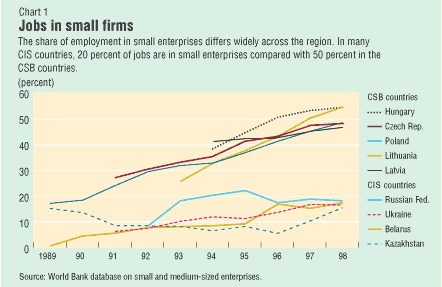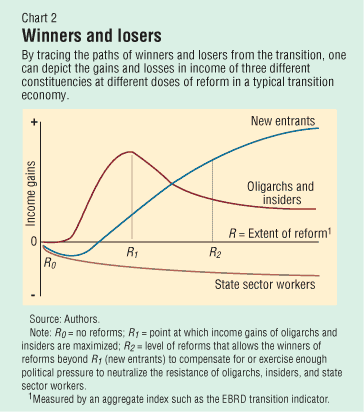 About F&D Subscribe Back Issues Write Us Copyright Information Free Email Notification Receive emails when we post new
items of interest to you. |
Lessons from a Decade of Transition in Eastern Europe and the former Soviet Union Pradeep K. Mitra and Marcelo Selowsky
A decade after the dissolution of the Soviet Union in late 1991, some transition economies are performing far better than others. A recent World Bank study finds that poor incentives for the creation of new firms is the single biggest obstacle. But reducing barriers to entry is not enough—hard budget constraints must also be imposed on the old money-losing state-owned enterprises.
The 1990s witnessed one of the most dramatic economic transformations in modern times, as the countries of Eastern Europe and the former Soviet Union abandoned central planning. Initially, output declined sharply, followed by a period of recovery in the late 1990s. But progress was extremely uneven across countries. In Central and Southeastern Europe and the Baltics (CSB), real output fell 22 percent from its 1990 level before it recovered in 1993. In the Commonwealth of Independent States (CIS), it plummeted 50 percent, not to begin recovering until 1999. By 2000, countries in the first group had more than restored their original output levels, while those in the second group were still 35 percent below. Moreover, progress varied greatly even within each group. Bulgaria and Hungary experienced the same initial output decline but, by 2000, Hungary's output was 10 percent higher, while Bulgaria's was still 13 percent lower. Moldova and Armenia had a similar initial drop, but while Moldova's output remained stagnant at that level, Armenia's output almost doubled thereafter. Why have some transition economies performed better than others? If reforms bring benefits, why have some governments been so reluctant to accept them? Should the policy prescriptions originally advanced now be revised, especially for those countries lagging behind? To answer these questions, the World Bank recently undertook a comprehensive study of the first 10 years of transition for this region. This article summarizes its findings. Why some did better By reviewing the economic literature, including additional econometric analysis undertaken for this study, we asked what explained the differences in economic performance: initial conditions, policy reforms, or external shocks, such as war and civil strife? Initial conditions were further disaggregated into several dimensions: the structure of the economy (share of industry, trade dependence on other communist countries), initial distortions (repressed inflation, black market exchange rates), and institutions (experience of markets and nationhood prior to transition). The extent of reforms was measured by combining the World Bank's liberalization index with the transition indicators of the European Bank for Reconstruction and Development (EBRD)—which include policies to increase the role of markets in resource allocation and reforms ensuring an efficient functioning of markets. What are the key findings?
Next, we asked what was the driving force behind growth at the microeconomic level. Productivity trends show significant differences across sectors and enterprises in the early days of transition, fueled by the liberalization of prices, decontrol of the service sector, and opening up of foreign trade. Old enterprises in heavily subsidized and protected sectors—such as energy-intensive sectors consuming heavily underpriced energy—saw their profitability collapse. Old enterprises in less protected sectors were able to recover profitability after some restructuring and downsizing. New enterprises became highly productive. Data from 10 economies covering leading and lagging reformers show that value added per worker was significantly higher in small enterprises (employing 50 or fewer workers), which are a good proxy for new enterprises. A survey conducted jointly by the EBRD and the World Bank comparing 4,000 old and new enterprises found that new enterprises outperformed old enterprises in the growth of sales, exports, investment, and employment. These comparisons of value added per worker indicate that a transfer of resources from predominantly capital-intensive old enterprises to generally more labor-intensive new ones should be a key source of growth, the recovery of growth reflecting the interplay between old and new enterprises. However, simply having a small number of highly productive new enterprises is not enough. New enterprises cannot be just a passive receptacle of labor shed by old enterprises. These enterprises have to evolve into active competitors for resources and rapidly increase their share of employment to develop a critical mass, which is precisely what happened (see Chart 1). In many CIS countries where growth remained low until the end of the decade, the share of employment in small enterprises hovered around 20 percent. In fast-growing Central Europe, in contrast, that share reached 50 percent. In Russia, it remained virtually stagnant toward the end of the decade, while it almost doubled in Poland. The evidence suggests that new enterprises must reach a threshold of around 40 percent in their contribution to employment before becoming the engine of aggregate growth, echoing the findings of the econometric analysis that reforms may have to incur an initial cost before benefits appear. Discipline and encouragement How do policymakers encourage this transfer of resources? Discipline must be imposed by hardening budget constraints on old enterprises to shed resources—for example, by eliminating budget transfers and ensuring payments of bank debts and energy bills, introducing competition, providing exit mechanisms, and putting in place systems to monitor managerial behavior. At the same time, new enterprises should be encouraged to grow to a critical mass. This requires improving the overall investment climate—reducing high marginal taxes and regulatory procedures, establishing secure property rights, and providing basic infrastructure. How effective policies have been in imposing market discipline on all firms and encouraging the creation of new firms holds the key to understanding why some countries have grown more than others.
 Can governments in the countries of Eastern Europe and the former Soviet Union try to promote growth by encouraging new firms while postponing the pain of liquidating the old sectors to a time when a cushion has been put in place? Is it possible to encourage new sectors and firms while protecting the old ones? The answer is no. Take the banking sector. In Bulgaria and Romania, small enterprises have grown more slowly because the banking sector was originally used, to a great extent, as a conduit for loans to state-owned enterprises. Nonperforming loans represented one-third of total loans in Romania as late as 1998, compared with 4 percent in Estonia, 6 percent in Hungary, and 11 percent in Poland—countries where new enterprises grew fast. These loans to old enterprises, which were not being repaid, prevented the expansion of bank credit to the new, smaller, and politically less-connected firms. In Belarus and Uzbekistan, the old sectors were protected through subsidized preallocations of foreign exchange and credit, the residual becoming available to new enterprises at much higher costs. As a result, small enterprises have been severely squeezed. In Belarus, the share of small enterprises in the total was a mere 26 percent—much lower than in the other CIS countries. Another example is protection of old, energy-intensive enterprises by allowing them to run arrears to energy utilities. This practice has been prevalent throughout most of the CIS countries. New, more efficient, and less energy-intensive firms were charged more to compensate for the revenue losses from nonpayment by the old sectors. Why eschew a good thing? If reforms underpinning discipline and encouragement are so beneficial, why have all countries not implemented them? Why have so many countries, particularly in the CIS, been stuck in a no-man's-land between plan and market? Chart 2 describes the gains and losses in income accruing to three typical constituencies as reforms intensify.
 Given these patterns of gains and losses, state workers prefer the status quo (R0) and oppose all reforms. Oligarchs and insiders prefer a partial reform scenario, supporting reforms only up to level R1. For potential new entrants, reforms would impose some temporary sacrifices, with the promise of increasing gains as reforms intensify. The risk of getting stuck at R1 depends both on the credibility of governments' following through with reforms and on the incentives of oligarchs and insiders to block them. The higher their peak income gain (particularly true in countries rich in natural resources and energy) and the sharper the reduction of those income gains as reforms accelerate, the stronger the power and incentives of this group to block reforms. And the less contestable the political system, the lower the costs to politicians of catering to a narrow but powerful constituency. In this situation, the economy will settle at a low-level partial reform equilibrium trap (R1)—an equilibrium with liberalization but limited discipline and encouragement—as has been the case in many transition countries in the CIS and Southeastern Europe that embarked on transition without a broad social consensus on the goals of reform and where incumbent politicians formed alliances with powerful incumbent enterprises. Can economies escape a partial reform equilibrium? Yes. Talented political leaders can maneuver countries out of so-called reform traps by mobilizing alternative coalitions and sparking collective action, in this case among smaller enterprises and those in the informal sector that suffer most from the poor investment climate and the discretionary nature of taxation and regulations, anticompetitive barriers, and payment of bribes. Chart 2 shows that once an economy is at R1, only reaching a critical threshold level (R2) through further reforms will generate additional gains among the new entrants to compensate for the losses of the other groups or generate the necessary political pressure to neutralize opposition to further reforms. Breaking out of a low-level partial reform equilibrium trap requires that a new reformist team overcome the coordination dilemma associated with the opposition from powerful and concentrated (actual) losers and from highly dispersed (potential) winners during the reform process. This requires linking in the public mind—for example, by using the media and civil society—the rents enjoyed from partial reforms (in the form of evaded taxes and nonpayment of arrears) and the direct costs to society (in the form of delayed public sector wages and poor social services). New policy priorities In light of the lessons culled from our study and today's "new initial conditions," how should we proceed on the policy front?
This article draws on the report, Transition—The First Ten Years: Analysis and Lessons for Eastern Europe and the Former Soviet Union (Washington: World Bank, 2002), which was prepared by a team led by the authors. The report is also available at www.worldbank.org.
|